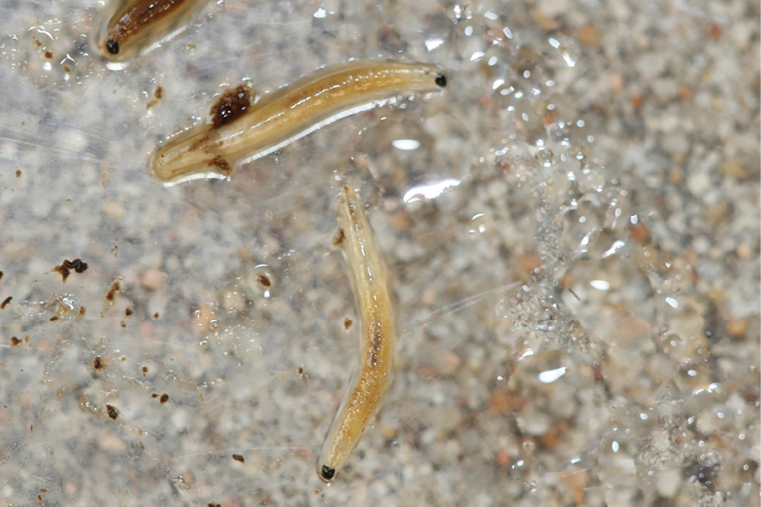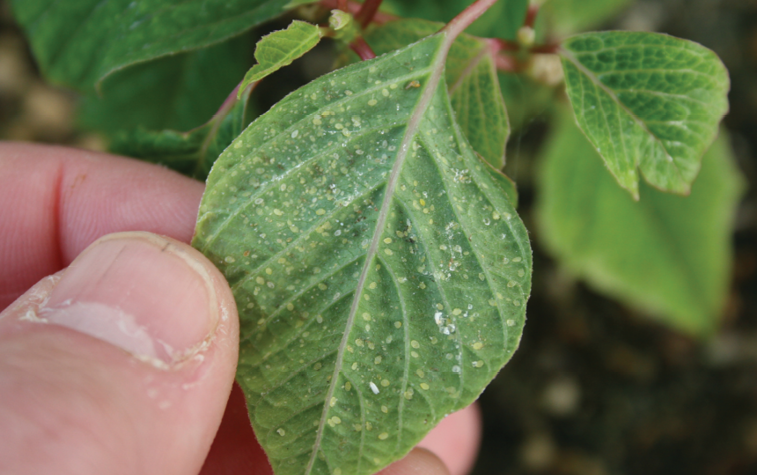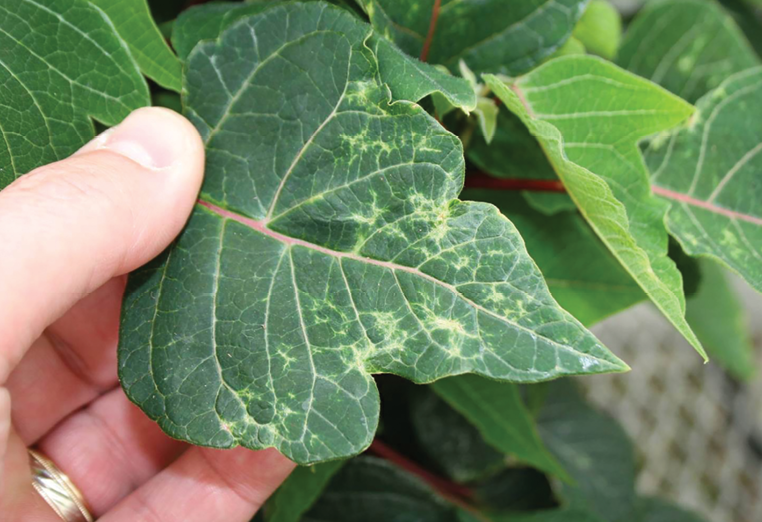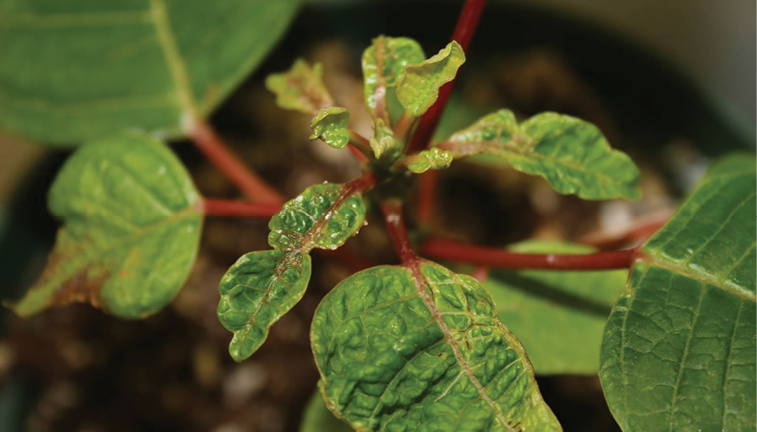
Poinsettias are susceptible to several insect and mite pests. It is important to effectively manage insect and mite pests on this popular crop, especially before bract formation, because very few insecticides and miticides are labeled for poinsettias when in bract. This article provides a brief description of the damage associated with each pest, as well as plant protection strategies, which will help to prevent damage to poinsettia crops.
Fungus gnats
Fungus gnat (Bradysia spp.) larvae (Fig. 1) feed on root hairs and small roots, inhibiting the ability of poinsettia plants to obtain water and nutrients. Fungus gnats are primarily a problem under propagation, when low larval numbers can kill cuttings or young plants.
Avoid keeping growing media excessively moist; remove weeds and old growing media from the production area; use pasteurized or bagged growing media; use yellow sticky cards to capture fungus gnat adults, which will help to detect early infestations; and use potato wedges for detection.
A number of insecticides can be used to suppress fungus gnat larval populations in the growing medium, including insect growth regulators (e.g. pyriproxyfen), contact insecticides (e.g. chlorfenapyr) and microbials (Bacillus thuringiensis subsp. israelensis). In addition, there are three biological control agents that are effective against fungus gnat larvae, including the rove beetle, Dalotia coriaria; the predatory mite, Stratiolaelaps scimitus; and the entomopathogenic nematode, Steinernema feltiae. The three biological control agents must be released before fungus gnat larval populations reach damaging levels.
Whiteflies
The sweet potato whitefly (Bemisia tabaci) is the primary insect pest of poinsettias, feeding within the vascular system (phloem sieve tubes) and removing plant fluids with their piercing-sucking mouthparts. In addition, the nymphs excrete honeydew, which is a clear, sticky liquid that serves as a substrate for black sooty mold. Whiteflies typically feed on the underside of poinsettia leaves (Fig. 2). Furthermore, all the life stages (eggs, nymphs, pupae and adults) are located on the leaf underside.
Remove weeds from within and around the greenhouse; avoid over-fertilizing poinsettias with water-soluble nitrogen-based fertilizers; remove leaf debris from production areas; use yellow sticky cards to capture whitefly adults, which will help to detect early infestations; and visually inspect the undersides of leaves for eggs, nymphs and pupae.
Contact insecticides (e.g. cyfluthrin), insect growth regulators (e.g. pyriproxyfen), selective feeding blockers (e.g. pymetrozine) and systemic insecticides (e.g. dinotefuran) can be used to suppress whitefly populations. In addition, the parasitoid, Eretmocerus eremicus, can be released early in the production cycle to regulate whitefly populations. Furthermore, entomopathogenic fungi, including Beauveria bassiana and Isaria fumosoroseus, are effective against whiteflies when applications are made early in the crop production cycle.

Western flower thrips
Western flower thrips (Frankliniella occidentalis) larvae and adults cause direct damage to the leaves and bracts of poinsettia plants that results in leaf scarring and distortion (Fig. 3).
Remove heavily infested or damaged plants; screen greenhouse openings, such as vents, with insect micro-screening; remove all weeds from within the greenhouse; use yellow sticky cards to capture adults, which will help detect early infestations; and shake leaves over a white sheet of paper to detect larvae and adults.
A number of insecticides can be used on poinsettias prior to bract formation to suppress populations of western flower thrips, such as spinosad, chlorfenapyr, pyridalyl and abamectin, as well as Beauveria bassiana, Isaria fumosoroseus and spirotetramat. Always apply insecticides early in the crop production cycle and repeat applications, if needed, based on scouting information.

Broad mites
The broad mite (Polyphagotarsonemus latus) is 1/100 of an inch long, and its eggs have bumps on the surface. A dissecting microscope will allow you to actually see the mites on plant leaves. Broad mite feeding causes distortion or deformation of the terminal leaves of poinsettias (Fig. 4). If you suspect broad mites are responsible for poinsettia damage, send samples to a diagnostic clinic for verification.
Remove all plants suspected to be or exhibiting damage caused by broad mites and routinely inspect plants for any visible damage that may be associated with broad mites.
Pesticides with miticidal activity may be used to manage broad mite populations, including abamectin, bifenazate + abamectin, chlorfenapyr, fenpyroximate, pyridaben, spiromesifen and spirotetramat. However, these pesticides must be applied before damage is observed; otherwise, it may be too late.

Lewis mites
The Lewis mite (Eotetranychus lewisi) is not a common pest problem of poinsettias, but greenhouse producers should be aware of this mite pest. The Lewis mite resembles the more common twospotted spider mite (Tetranychus urticae) but is smaller. Lewis mites feed on the lower leaves and cause damage on poinsettias that may resemble a nutritional deficiency (Fig. 5).
Remove all weeds from within the greenhouse that may serve as an alternate host plant for Lewis mites; avoid over-fertilizing plants with water-soluble nitrogen-based fertilizers; inspect leaf undersides; and shake leaves over a white sheet of paper for detection.
Miticides with contact or translaminar activity (material penetrates leaf tissues and forms a reservoir of active ingredient within the leaf that provides residual activity after spray residues have dissipated) can be used against Lewis mites, as well as certain biological control agents, including predatory mites and the predatory midge (Feltiella acarisuga). Check miticide labels to determine those that are registered for use against the Lewis mite. Furthermore, consult with your biological control supplier to determine which predatory mites should be released to regulate Lewis mite populations.

Mealybugs
Mealybugs have become more of a problem, perhaps because systemic insecticides applied to the growing medium may not be effective against this pest on poinsettias. Populations may build up and potentially displace other insect pests that are susceptible to systemic insecticides. Mealybugs feed on the leaf underside, on the plant stem (Fig. 6) and near the base of the petioles. Mealybugs can cause leaf distortion, plant stunting and wilting. Also like whiteflies, mealybugs excrete copious amounts of honeydew, which serves as a substrate for black sooty mold.
Dispose of heavily infested plants; avoid over-fertilizing plants with water-soluble nitrogen-based fertilizers; and inspect plants for mealybug life stages, including nymphs (crawlers) and egg-laying females.
Mealybug populations may be suppressed on poinsettia plants before bract formation using insecticides such as acetamiprid, pyrifluquinazon, flupyradifurone, mineral oil and buprofezin. However, multiple applications will be required.

Protection strategies
A number of insect and mite pests may feed on poinsettia plants during the growing season. However, greenhouse producers can alleviate problems with a multitude of plant protection strategies, including cultural control, scouting, pesticides and biological control. Always be proactive when dealing with insect or mite pests that feed on poinsettias — options are limited once poinsettias are forming bracts.

Explore the August 2024 Issue
Check out more from this issue and find your next story to read.
Latest from Greenhouse Management
- Pennsylvania Horticultural Society shares top gardening trends from 2025 Philadelphia Flower Show
- California Spring Trials 2026 dates announced
- Les Evans promoted to DRAMMwater segment manager, Al Zylstra to retire
- Hoffmann Family of Companies to acquire N.G. Heimos Greenhouses
- GIE Media Horticulture Group wins five regional 2025 Azbee Awards of Excellence
- Grant awarded to test western U.S. wood species for use as wood fiber potting substrate
- Pennsylvania Horticultural Society announces 2025 Gold Medal Plant winners
- Oasis Grower Solutions announces new Southeast territory sales manager





